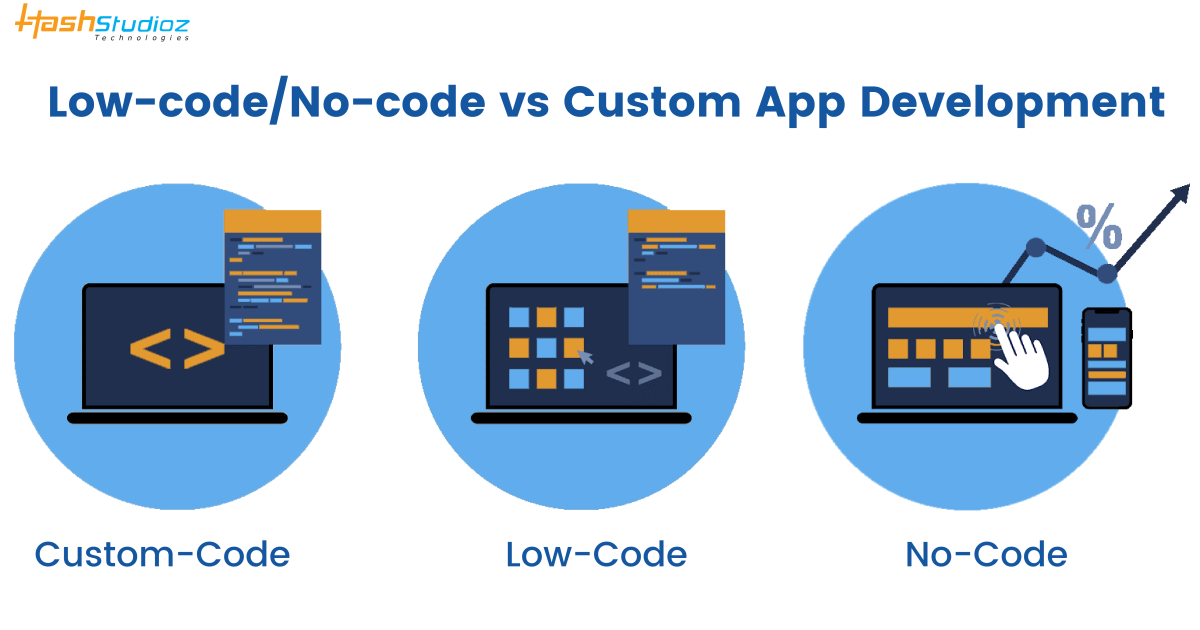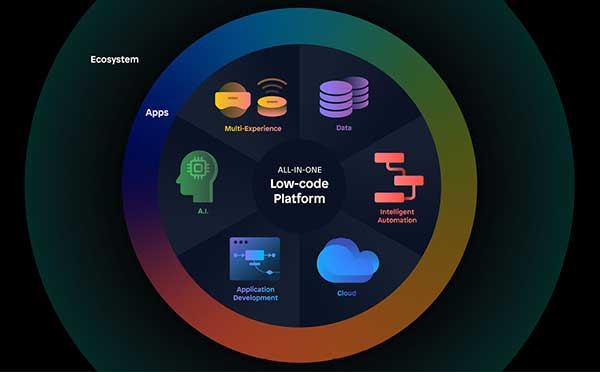The following factors are key to making low-code development available to non-developers.
Drag-and-Drop Builders: Low-code platforms have drag-and drop interfaces, which allow non-developers develop applications without needing to write code. This makes it easier for people with no technical background to participate in the development process.
WYSIWYG Editors: "What You See Is What You Get" editors let users create interfaces and workflows in the same way as the actual product, which makes it easier to understand and use.
Simplified workflow and logic
Visual Workflow Modeling: Users can develop business processes and apply logic through visual flowcharts and models that are easier to understand than the traditional methods of coding.
Pre-built Components of Logic Low-code platform often includes already-built logic (e.g. loops and conditional statements) that can easily be set up, eliminating the requirement for complicated programming.
Reusable Components & Templates
Library of Templates Pre-built: Many platforms that offer low-code have a library of template types for the most common applications. This allows developers to start quickly and efficiently and non-developers to modify the templates however they see appropriate.
Reusable Widgets and Modules Users can use the widgets that can be reused. This simplifies the creation and eliminates the requirement for extensive understanding.
Guided Development and Tutorials
Step-by-Step Instructions: Platforms typically provide a development path with guidance or online tutorials on-screen directions to help users who aren't developers to create applications.
Interactive Tutorials Interactive, hands-on tutorials help users learn by doing, improving their knowledge and confidence using the platform.
Integration with existing tools:
Easy integration Low-code platforms are developed to integrate seamlessly with the existing business tools and systems (e.g. ERP, CRM) allowing non-developers create applications in their existing workflows.
APIs Connectors: APIs integrate into apps to facilitate integration. This allows non-developers, who do not have coding skills, to connect to external services.
Collaboration Features:
Team Collaboration: Features such as real-time collaboration, as well as shared workspaces allow non-developers to work alongside business analysts, professional developers and other stakeholder groups effectively.
Access levels can be set for those who are not developers to make sure they are able to contribute to the development process, but without compromising security.
Automated Debugging and Testing:
Low-code platforms usually come with debugging and testing software that can automatize these processes. This makes it simpler for non-developers to check their applications work correctly.
Error Highlighting - When problems occur, the system highlights the issue and offers solutions, guiding users through troubleshooting.
The main benefit of low-code development for accessibility for non-developers is in its ability to democratize the development process. Low-code platforms allow business users to be involved in the creation and maintenance of applications through the use of intuitive visual tools and a guided experience. This is a bridge between technical implementation and business demands. Take a look at the recommended great post to read for Low-code Platform for application development for site info including cross platform app development, database in azure, mobile app development platforms, cross platform mobile development, cross platform mobile development, lowcode no code, cross platform mobile development, database in azure, application modernisation, rad application development and more.

Benefits Of Low-Code Application Development In Terms Of Scalability And Flexibility
Low-code applications have a number of advantages when it comes to scaleability. They are flexible and can be adjusted to accommodate new needs. Here are some of the main benefits Rapid scaling:
Cloud-Based Platforms: A lot of platforms that support low-code are cloud-based. They allow applications to easily scale up and down with the cloud infrastructure. Businesses can handle greater load without having to worry much about server administration.
Auto-Scaling: The auto-scaling feature will automatically adjust the resources according to the demand. This ensures constant performance during peak times with no manual intervention.
Flexible Architecture:
Low-code platforms encourage modular design, allowing components to independently be designed, evaluated and scaled. Modularity increases flexibility and allows for easier upgrades or expansions of certain components without affecting the overall system.
Microservices Integration Support for microservices architecture allows applications to be built by combining loosely coupled service, increasing the scalability as well as flexibility.
Customizable Options:
Extensibility: Low-code platforms usually allow for customized scripting and programming which allows developers to extend the capabilities of apps beyond what is available in the box. Developers can meet their specific business requirements without any restrictions.
Third-Party Integrations: Companies are able to integrate additional functionality and features into their applications by integrating with APIs and third-party services.
Agile Development and Deployment
Continuous Delivery and Deployment Low-code platforms support agile methods which allow continuous integration, continuous delivery (CI/CD). This enables rapid deployment of features and updates. Applications are then able to grow rapidly in response to market developments and user feedback.
Iterative Development: The nature of development using low-code ensures applications are able to be improved incrementally and scaled up, reducing the risk associated with large-scale changes and allowing for greater control over growth.
Resource Optimization
Effective Resource Management: Low Code platforms can optimize resource usage through tools that track and control the performance of applications. They ensure that resources can be utilized effectively and efficiently scaled up or back down according to the actual needs.
Load Balance: This feature lets the application handle massive traffic by distributing workloads across several servers. It also ensures that the application's performance is constant.
Global Reach
Multi-Region Accessibility: Lowcode platforms allow to be used across a variety of regions. Companies can provide users with low-latency worldwide access. This is vital for applications that serve a global audience.
Localization Support for Localization included, which allows for applications to be easily adjusted for different languages or regional demands. This allows for greater flexibility in diverse markets.
Updates and maintenance
Simple Maintenance : Low-code apps' visual and modular nature simplify maintenance tasks. This allows bugs and updates to be implemented quickly, without long periods of downtime.
Version Control Version Control: Systems that integrate version control oversee rollbacks and changes to ensure that updates can safely be made and that older versions can restored if necessary.
Cost Efficiency:
Lower development costs: By reducing the need for a lot of code, low-code platforms cut down on development costs and enable to scale applications without a proportional increase in development expenditure and effort.
Pay-As you Go Models Numerous platforms that are low-code provide flexible pricing options, like pay-as-you-go model that aligns the cost and usage to actual growth.
Overall, the scalability and flexibility advantages of low-code applications enable businesses to build robust, flexible and scalable apps efficiently. These platforms allow quick adjustments to changing demand as well as efficient utilization of resources and continual improvement. Applications can expand and change with the business. See the best Legacy application modernization with Low-code for website examples including developing mobile apps, application development platforms, software for app development, rapid action development, application development platforms, cross platform mobile app development, cross platform app dev, mobile app development platforms, app modernisation, cross platform mobile dev and more.

Low-Code Applications Offer Benefits In The Area Of Collaboration And Workflow
It's a great option for companies that wish to increase team productivity, streamline processes and improve collaboration. Here are a few of the benefits.
Unified Development Environment. Low-code platforms let all team members work in a single and unified environment. This includes business analysts, developers, designers, and stakeholder. This helps to eliminate barriers and improve communication.
Visual Development Tools: Low-code platforms are easy to use, and come with the drag-and-drop interface. This lets non-technical people on the team to take part in the process of development, which ensures that business requirements can be gathered precisely.
Communication Enhanced:
Real-Time collaboration: Many low-code platforms offer real-time communications features, including simultaneous editing and commenting. Feedback is instantaneously available. This can help reduce the amount of time required to have a back and forth conversation.
Shared Workspaces Teams can collaborate by sharing workspaces. These workspaces permit them to review, edit and discuss project elements.
A streamlined workflow management system:
Built-in Project Management Tools : Low code platforms often include integrated project management software that aids teams plan, track, organize, and manage their projects for development. This includes the management of tasks, tracking progress and management of deadlines.
Automation of routine workflows and activities can reduce mistakes and manual labor which allows teams and individuals to concentrate on strategic projects and increase efficiency.
Speedier Iteration cycles
Rapid Prototyping Low-Code platforms are great for speedy prototyping. Iterative development is also possible which allows the team to experiment, create and refine their software within shorter time. This ensures feedback can be quickly integrated and changes are made.
Agile Development Support: Facilitating agile methodologies allows individuals and teams to work in small increments. This allows them to quickly adapt to changes.
Accessibility for Non-Developers:
Citizen Development: Low-code platforms allow business users the capability to develop and modify applications without extensive coding skills. This makes it easier for IT teams as well as developers, enabling them to respond faster to business demands.
Training and Onboarding: Easy interfaces and extensive training resources make it easier for new members to learn the ropes and improve the overall cohesion within the team.
Centralized Documentation & Knowledge Sharing
Integration of Documentation: Low-code platforms typically include tools for creating and maintaining documents within the platform and ensuring that all project data is centralized and easily accessible.
Knowledge Repositories. Teams can create repository for knowledge that includes templates and reusable parts. This will help facilitate knowledge sharing and decrease duplication.
Standardization and Consistency:
Standardized Components: The use of standardized components that are pre-built and built provides the sameness between applications. This makes it simpler for team members to grasp the different components of a given project and to work on these components.
Governance and Compliance: The built-in frameworks for governance ensure that each development adheres to the organizational guidelines and regulations which reduces the risk of non-compliance and making sure that the applications are in compliance with quality standards.
Feedback and Improvement Loops
Integrated Feedback Mechanisms: Low-code platforms often provide integrated feedback mechanisms, which allow users to easily provide feedback on applications, which can later be integrated into the process of development.
Continuous Improvement: The ability of quickly iterating and deploying modifications based on feedback assures that the software is continuously developed, while being in tune with the requirements and goals of the users.
Visualization and Reporting
Real-Time Analysis Tools for Analytics and Reporting built into the software provide real-time information on the progress of projects along with user interaction and overall performance. This allows for data-driven decision making.
Visual Workflow Maps: Tools for mapping processes or workflows are useful to teams in understanding their workflows. They can also identify the bottlenecks that are present, as well as areas that require improvement.
Low-code application development can be a very effective tool for collaboration and workflow. It connects different teams, streamlines communication, and streamlines processes. This creates a more collaborative atmosphere with a quick and efficient process for development, which results in better-quality applications and better alignment between business goals.
